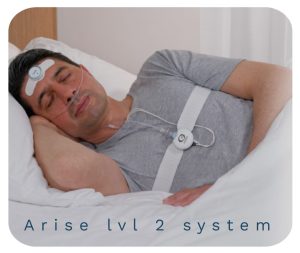Home Sleep Study / Sleep Apnoea Test
Home Sleep Study
What is a Home Sleep Study?
A sleep study, known as Polysomnography (PSG), helps diagnose sleep disorders. A home sleep study, or Ambulatory Polysomnography Test, offers a convenient alternative to in-lab sleep studies. We partner with Arise, a leader in home sleep studies, to provide this service.
Understanding Home Sleep Studies
A Home Sleep Study (HSS), also referred to as a Home Sleep Test (HST), is a convenient and effective way to assess sleep quality and detect sleep-related issues such as snoring and obstructive sleep apnoea. During the study, various vital signs are measured, including heart rate, respiratory rate, breathing patterns and effort, oxygen levels and sleep stages.
Do You Need a Sleep Study?
Consider a sleep study if you experience:
- Snoring
- Waking up gasping for air (or being told you stop breathing at night)
- Choking at night
- Clenching or grinding your teeth at night
- Waking up feeling unrefreshed
- Morning headaches
- Daytime sleepiness or exhaustion
Associated health issues that may indicate the need for a sleep study include:
- Diabetes
- High Blood Pressure
- Obesity (BMI >35)
Benefits of a Home Sleep Study
- Convenience: Conduct the study in the comfort of your own bed and in-line with your regular bedtime routine.
- Cost-effective: More affordable than hospital-based studies, with a total cost of $150.
- Less intimidating: A familiar home environment can be more comfortable and less stressful.
- Quick turnaround: Booking is typically available within 1-2 weeks, with results in 2-3 weeks.
How is a Home Sleep Study Conducted?
On the designated night, you will wear the sleep study device to bed. Our Sleep Study Set-Up Instructions will guide you on how to attach the sleep study device to your forehead and chest.
The next morning, return the device to our clinic. The data is uploaded and analysed by an Australian based, independent Sleep Physician, who will diagnose any sleep disorder found, and determine its severity.
Steps to Undertake a Home Sleep Study
- Book Online and Pay: (HYPERLINK WILL BE SUPPLIED)
This is a simple process and includes a short questionnaire (allow 5-10 mins). - Collect the device from us: We will call you when your pre-programmed Home Sleep Study Device is ready for pick-up from our clinic.
- Sleep with the device on the nominated night: This was selected in your booking and programmed into the device.
- Return the device: Bring the device back to our clinic the next morning.
- 5. Data analysis: The recorded data is analysed and reported on by an independant Australian based Sleep Physician.
- Receive results: You will get a summary of your results and a diagnosis within 2-3 weeks.
- Follow-up: Schedule an appointment with your referrer to discuss your results and treatment options.
Treatment for Sleep Apnoea
- Mild to Moderate OSA: A Mandibular Advancement Splint (MAS), a custom-fitted device, helps open your airway by advancing the lower jaw. This splint is customised for you by first taking a detailed 3D scan of your teeth following which the data is sent to a lab for manufacture. The MAS is designed to advance your bottom jaw to open up the airway.
- Severe OSA: A CPAP machine, which provides continuous positive airway pressure through a mask, may be necessary. If CPAP is intolerable, a MAS might be a suitable alternative.
Addressing other associated issues is also an important part of treatment. These include weight loss if required, doing regular exercise, and adopting better sleep hygiene habits (night time habits).
Connection Between Sleep Apnoea and Temporomandibular Disorder (TMD)
While sleep apnoea and TMD are separate conditions, there is evidence to suggest that they can be linked. One study found that people with TMD were more likely to also have sleep apnoea than people without TMD. This is thought to be because TMD can cause changes in the structure of the upper airway, which can increase the risk of airway obstruction and, therefore, sleep apnoea Conversely, sleep apnoea may also contribute to TMD. This is because the repeated episodes of breathing pauses and gasping for air can cause muscle tension in the jaw and face, leading to jaw pain and other TMD symptoms. Clenching and grinding, can be symptoms common to both.
Additionally, it is important to ensure that when beginning to use as MAS, that this does not lead to discomfort in the jaw, neck or head. Other symptoms to watch out for are earache, blocking or ringing. These may all be signs that your joints and muscles are stiff / tight and require treatment so that you can wear your MAS without any issues.


